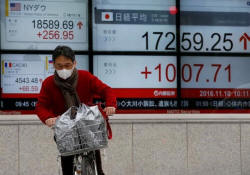|
Dollar soars as U.S.
yields spike; shares divided
 Send a link to a friend
Send a link to a friend
 [November 14, 2016]
By Marc Jones [November 14, 2016]
By Marc Jones
LONDON
(Reuters) - The U.S. dollar hit an 11-month peak on Monday as the risk
of faster inflation and wider budget deficits, if president-elect Donald
Trump should go on a U.S. spending spree, sent Treasury and other
benchmark global bond yields shooting higher.
Currencies in many emerging markets - from the Mexican peso to the
Malaysian ringgit - fell to new lows and for share markets it made for a
mixed start to the week.
The pan-European STOXX 600 index had lost much of its early buoyancy by
the time U.S. trading neared but was still up 0.2 percent as banks eyed
a boost from higher interest rates and mining company shares rose on the
back of Trump's promises of major infrastructure spending.
The reflation trade also saw futures for the S&P 500 and Dow Jones
industrial add another 0.2 percent to 0.5 percent after the Dow chalked
up its best week for five years last week.
The dollar meanwhile bounded toward 108 yen, having hit and then dropped
back from the eye-catching 100 threshold on the index that
measures it against the world's other major currencies.
Trade was brisk with the greenback's rally taking the pace off a
resurgent sterling and seeing the euro slide to its lowest since the
start of the year at about $1.0745.
"Clearly the market has settled on a 'buy dollar' theme on the basis
there will be a debt-fueled U.S. fiscal binge that will push up
inflation," TD Securities European Head of Currency Strategy Ned
Rumpeltin said.

"People are repricing the Fed on the basis of that so it all seems to be
a relatively straightforward."
The dollar has been romping ahead since Trump won the U.S. presidential
election on Nov. 8, triggering a massive sell-off in Treasuries.
Yields on the U.S. 10-year Treasury notes climbed to their highest since
January on Monday at 2.28 percent, while 30-year paper reached 3
percent. German 30-year yields topped 1 percent for the first time in
more than six months. [GVD/EUR]
Just two days of selling last week wiped out more than $1 trillion
across global bond markets, the worst rout in nearly a year and a half,
according to Bank of America Merrill Lynch.
The jump in yields on safe-haven U.S. debt threatened to suck funds out
of emerging markets, while the risk of a trade war between the United
States and China is also causing jitters.
"There are signs that higher bond yields and the knock of a stronger
U.S. dollar are having a domino impact, taking down the weakest risky
assets first, before moving on to the next," Deutsche's global co-head
of forex, Alan Ruskin, said.
"There is only so much financial conditions tightening that risky assets
can take when fiscal stimulus is still a promise that lies some way in
the future."
The stampede from bonds has seen 30-year yields post their biggest
weekly increase since January 2009 and the 50-basis-point move in
10-year bonds is the equivalent of two standard interest rate hikes.
Three Federal Reserve officials are due to speak later.

[to top of second column] |

A man cycles in front of electronic boards showing Japan's Nikkei
average (R) and the Dow Jones average (L top) outside a brokerage in
Tokyo, Japan, November 10, 2016. REUTERS/Toru Hanai

SUBMERGING MARKETS
Mexico's peso, Turkey's Lira and South Africa's rand were all at the
center of the sell-off. Emerging market stocks also extended their post-U.S.
election slump to more than 7 percent.
MSCI's broadest index of Asia-Pacific shares outside Japan ended
at its lowest since mid-July as Hong Kong and Indonesia led the region's
losses with drops of 2.7 and 2.2 percent .
By contrast, Japan's Nikkei jumped 1.7 percent on the weakening yen to
hit its highest in nine months.
It got an added fillip from data showing Japan's economy grew at an
annualized rate of 2.2 percent in the third quarter, handily beating
forecasts.
Elsewhere, the New Zealand dollar eased after an earthquake on Monday
that killed at least two people and prompted a tsunami warning that sent
thousands fleeing to higher ground.
The currency dipped to $0.7092, with losses limited by talk that
rebuilding work would support an already strong economy and lessen the
need for further interest rate cuts.
Egypt's pound strengthened, meanwhile, after the International Monetary
Fund approved a $12 billion, three-year loan program the government
hopes will help restore investor confidence and stabilize the currency
and economy.
In commodities, the rampant U.S. dollar put pressure on gold, which lost
0.8 percent to $1,215 an ounce. It has lost 7 percent over the last
week. Yet, industrial metals extended their bull run, with copper adding
1.2 percent.
In the oil market, Brent crude began backsliding, dipping 70 cents to
$44.17 a barrel, while U.S. crude eased 60 cents to $42.75. [O/R]
One market rate, measuring expected U.S. inflation over the five-year
period that begins five years from today, shot up 30 basis points to
2.46 percent last week, the highest since late 2014. It had been
as low as 1.84 percent in June.
Fed fund futures in turn imply a better-than-70-percent probability the
Fed will hike rates in December.
Speaking in Frankfurt, European Central Bank Vice President Vitor
Constancio warned about the uncertainty being caused by the sudden swing
in markets.

"We should be cautious in drawing hasty, positive conclusions from those
market developments because they may not necessarily indicate that the
world economy will have an accelerating recovery with higher growth," he
said.
(Additional Reporting by Wayne Cole in Sydney; Editing by Louise
Ireland)
[© 2016 Thomson Reuters. All rights
reserved.] Copyright 2016 Reuters. All rights reserved. This material may not be published,
broadcast, rewritten or redistributed. |